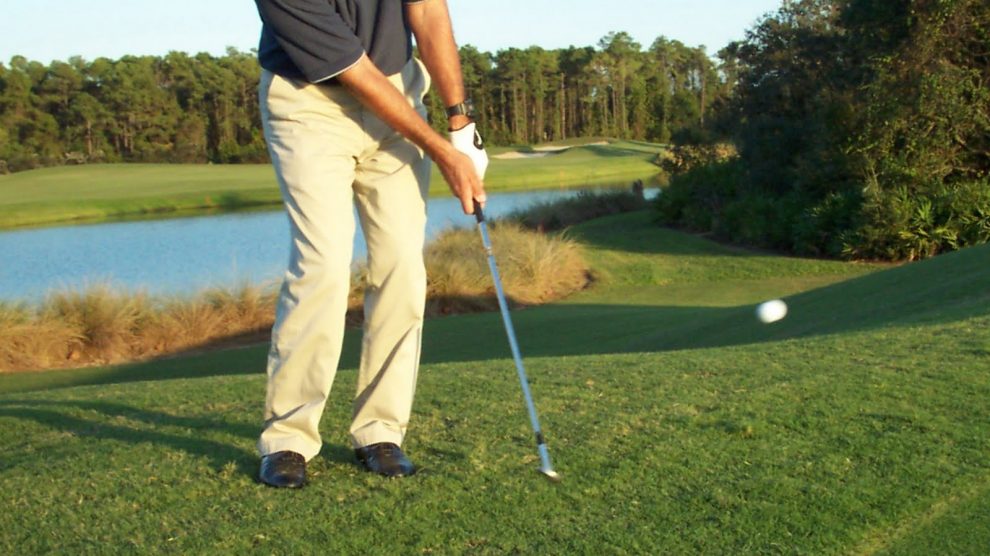The hardest shots in golf are the ones that require the most touch. They're the ones with little margin for error. So, when you stand over the golf ball facing a tough touch shot, you need to have a game plan and confidence that what you think is going to happen is exactly what's going to happen (even if it doesn't).
When I play golf, I see so many players get over the ball without either a plan or confidence. They kinda guess at what club they're going to use. Their practice strokes don't match what they wind up trying to do. They have no idea how the shot will turn out after the ball hits the ground.
If you want to improve your pitching, chipping, sand play, flop shots and all of the touch shots, then you need to do three things before you pull the trigger:
- Determine which shot you're going to play
- Visualize or simulate in your mind the complete shot, from start to finish
- Make practice swings helping you visualize the right swing for that shot
Determining which shot to play
Before you get into the pre-shot routine, you need to figure out a game plan for the shot you're going to hit. That means assessing several things.
- One, you need to know the kind of lie you have. Is it fluffy? Is the ball sitting up or down? Is the turf firm, soft or in the middle?
- Two, you need to know what's in front of you. Do you have to clear a bunker? Is there a false front you need to carry?
- Three, you need to know the turf in front of your target. Will your shot be landing on a downslope? Are you pitching uphill? Will there be a slope or break moving your ball as soon as it hits the ground?
All of these things should inform your choice. Obviously, the choice isn't always the same. In fact, it's rarely the same. However, with this information, you can figure out if you need to go high, medium or low. You can figure out how which loft to use. You can figure out how hard you'll have to swing. You can figure out if you need to impart a lot of spin on the ball to get it to stop quickly or if you can let it run out toward the target.
Now that you know the shot you want to play, you need to prepare for that shot.
Visualizing the shot from start to finish
Lots of golfers visualize their shot before they hit it. That's good. The problem is that most golfers don't visualize what's going to happen after the ball hits the target. After all, the golf ball typically doesn't just hit the target and stay in place. It bounces and spins. It rolls out. It can back up. That's why it is crucial for a golfer to visualize the shot from start (the swing) to finish (when the ball actually stops).
If you think the ball needs to run out and go uphill, then pick a target where it will run close to where you want the ball to stop. If you're planning on a shot with a lot of spin, don't visualize a shot where the ball runs out a long way. If the shot will land on a slope with break, play for that break.
In other words, visualize touch shots like you would a putt. Assess the landing area and the path from there to your desired ending place for the ball (ideally, the hole). That will help you turn your analysis into a vision. With good practice swings, you can turn that vision into a reality.
Practicing for the shot you want to hit
Golfers often make lackadaisical practice swings. They're kind of generic. They'd work in almost any situation, therefore, they work in almost no situation. Every touch shot in golf has a specific set of demands, and your game planning and sleuthing just informed you what shot to select. Now, you have to practice for that shot. Practice it down to the letter.
The first swing is usually a first pass. Is that about how far to take it back? Should you open the face? Are you coming in steep or shallow? There are several ways to hit most touch shots, so you need to decide the technique that will get the job done with confidence and practice it.
Don't waffle. If you prepare specifically, you'll miss specifically. If you prepare generally, you'll miss generally.
The most important thing in executing difficult golf shots in having a well-executed plan. Even if the plan is wrong, that's better for you long-term than not executing a good plan. Having the confidence to stand over the ball and hit the shot you think needs to be hit will help you time after time to get back over the ball and not sweat bullets.

